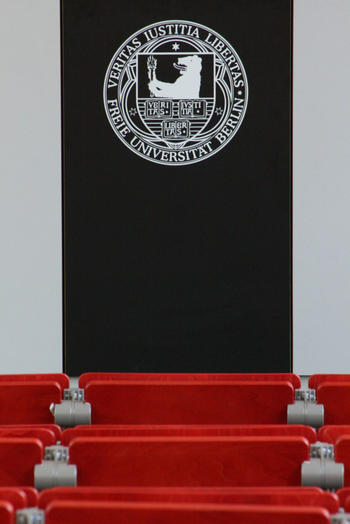Guiding Principles and History of Freie Universität
Freedom as a Founding Impulse
Freie Universität Berlin was founded in 1948 by professors and students, in response to the persecution faced by students who took a critical eye of the system at Universität Unter den Linden, at that time located in the Soviet sector of the divided city. The idea of founding a free university found widespread support in the international community, including financial support. This outpouring of aid helped pave the way for Freie Universität to become a university with an outstanding international reputation. The principles of freedom and internationality have guided the university’s development ever since. Since the university’s founding, in December of 1948, the academic ethos of Freie Universität Berlin has always been defined by three values: truth, justice, and freedom.

Image Credit: Thiago Menezes
The University in a Changing Era
The years 1968, 1990, and 2007 mark turning points in the history of Freie Universität. The university was one of the central sites in Germany for the student protests of the 1960s, a movement that sparked a trend toward greater openness, equality, and democracy.
Then, after German reunification in 1990, Freie Universität Berlin shifted its emphasis, increasing its research activities. The number of graduates, successful doctoral candidates, and publications also grew by a significant measure. The basis for the university’s successful new approach was a series of fundamental reforms, including the introduction of modern management structures in the university’s administration, reorganization of the departments, and use of funding to support specific aims.
In 2007, Freie Universität Berlin was selected in the Excellence Initiative jointly sponsored by the German federal government and the governments of the federal states. It was one of nine universities in Germany to receive distinction in all three lines of funding, a step that has enabled the university to solidify and further expand its position as an “international network university.” In 2012 during the second funding round of the Excellence Initiative, it was selected again and is now one of eleven universities of excellence in Germany.
Facts and Figures
- Founding year: 1948
- Students: 30,000 students in bachelor’s and master’s degree programs (WS 2020/21)
- Students from abroad: 13 percent in bachelor’s degree programs; 28 percent in master’s degree programs
- Doctoral students: 4,000
- Doctoral students from abroad: 36 percent
- Professors: 376, incl. 51 joint appointments with non-university research institutes; 93 fixed-term professors
- Staff: 4,550
- Departments and central institutes: 11 academic departments, 1 joint medical school with Humboldt-Universität, 4 transdisciplinary central institutes
- Degree programs: 178
- Undergraduate degree programs: 73
- Consecutive master’s degree programs: 105
- Doctoral programs: 51
- Collaborative research centers (DFG): 8 as host university, 14 as participating institution, 3 as part of Charité – Universitätsmedizin Berlin, and 9 as participating institution
- Annual government funding: 360 million euros p. a. of which 65 million euros are for pension and health plans
- External funding expenditures: 140 million euros (2019)
Figures do not include medicine unless stated otherwise; 2020 unless stated otherwise.

